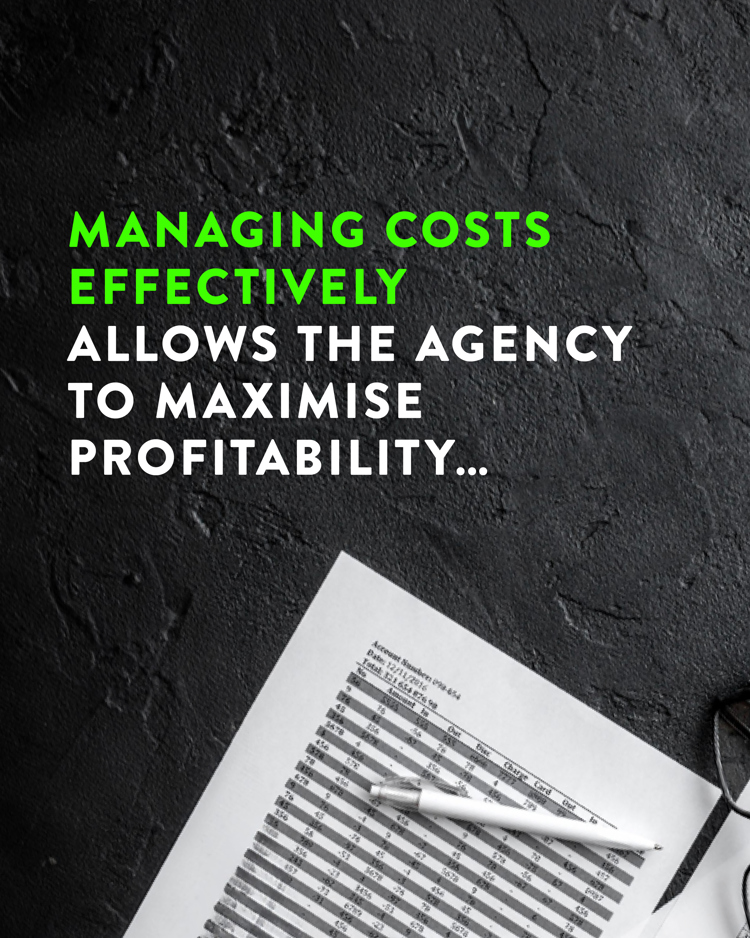Optimise financial operations to support your growth and sustainability










 Running the finances in a marketing agency successfully requires a blend of strategic planning, diligent monitoring, and adaptive management.
Running the finances in a marketing agency successfully requires a blend of strategic planning, diligent monitoring, and adaptive management.
Whether you're a seasoned professional or a startup owner, maintaining financial health is crucial for sustained growth and stability. Oakwood’s finance management model is always evolving, especially when it comes to reporting and analytics. Above all I strive to report in a timely, clear and easily digestible format.
I have always maintained the key to successful financial planning is making sure you report on time, publishing a set of reports late in the month or ineffectual cashflow reviews, mean you are less agile and unable to make quick decisions, anyone will tell you agency life means that things move quickly and you want to be able to have a robust financial platform to withstand the curve balls clients will throw your way.
This is my strategy.
1. Establish a Robust Financial Foundation
 Create a detailed budget, both PNL and Balance Sheet - starting with a comprehensive budget that outlines all expected expenses and projected income. We start this in the final quarter of the financial year as this gives us a steer on how the year has performed and helps to anticipate what the running costs for the next financial year will be, allowing us to build in expenditure for events, client engagement projects, tech and people investments we want to make in the year.
Create a detailed budget, both PNL and Balance Sheet - starting with a comprehensive budget that outlines all expected expenses and projected income. We start this in the final quarter of the financial year as this gives us a steer on how the year has performed and helps to anticipate what the running costs for the next financial year will be, allowing us to build in expenditure for events, client engagement projects, tech and people investments we want to make in the year.
Running alongside this the client services team will project their sales for the year together with their contribution margins, this is made up of a blend of new business targets, client growth, and existing billing performance. As Oakwood has a long track record of client retention, building excellent relationships with our clients makes our revenue planning easier to anticipate.
 Using this information, we can also predict what my VAT, PAYE, and Corporation Tax could look like and factor this into our cashflow.
Using this information, we can also predict what my VAT, PAYE, and Corporation Tax could look like and factor this into our cashflow.
We include a flex budget, the one we use to measure performance is possibly slightly pessimistic and the secondary flex budget is aspirational, you would be surprised the number of years we have come close, and on occasion, achieved the aspirational budget, so it’s something we have always done to see how far we can push ourselves.
2. Get together for weekly forecasting, cash, and sales.
 Once you have got a handle on your budgeting then the rest of the work falls into place, you know your staffing costs, your operational costs and your income and can plan this weekly in your cashflow and helps you to then have a long-term view of your cash availability, profitability is nice, but liquidity is essential, this is my mantra. We target ourselves to have a 6-month view of our cash reserves and a 3-month view of our forecasted sales, sometimes the view isn’t pretty, but it gives you time to make key decisions, which proved crucial during the COVID pandemic.
Once you have got a handle on your budgeting then the rest of the work falls into place, you know your staffing costs, your operational costs and your income and can plan this weekly in your cashflow and helps you to then have a long-term view of your cash availability, profitability is nice, but liquidity is essential, this is my mantra. We target ourselves to have a 6-month view of our cash reserves and a 3-month view of our forecasted sales, sometimes the view isn’t pretty, but it gives you time to make key decisions, which proved crucial during the COVID pandemic.
We have a finance meeting weekly with the client services team, we have a blend of what we know will convert in the month, and a separate list of work which has an over 80% chance of landing in the month. Together with this the client services team also report what their cost of sales will be for the activity they are working on. This helps us to know what revenue to expect and tells us how much to allocate for suppliers in the cashflow.
 We tend to send our sales invoices out as soon as we have completed the work, this reduces the waiting time for payment if we have clients which take longer than 30 days to pay, which also helps our cash forecasting to be more robust.
We tend to send our sales invoices out as soon as we have completed the work, this reduces the waiting time for payment if we have clients which take longer than 30 days to pay, which also helps our cash forecasting to be more robust.
We use this information in 2 ways, we add into the cashflow what our actual sales will be and when our clients will pay us to help forecast rolling cash availability.
We then look at the actual sales and the potential sales for the month and draw up a mini PNL based on this, which helps us to anticipate if we will make a loss or a profit in the month.
This is a weekly routine, a cashflow statement and a profit statement is issued to the board of directors every Friday afternoon.
3. Monthly Management Accounts
 Sales close on the last day of the month and the purchases are closed on the 3rd day of the month, Management Accounts are produced by the end of the first week of the new month.
Sales close on the last day of the month and the purchases are closed on the 3rd day of the month, Management Accounts are produced by the end of the first week of the new month.
Due to the weekly nature of our forecasting the accounts are always in a near to complete state, and then all we have to do is reconcile the client billing and ensure we are not over recognising contribution (revenue) in the month.
The budgets we have prepared are included in these figures, so we can track and analyse any overspend digging into these figures to see if it’s a trend or a one off.
The accounts are then issued to the directors, detailed PNL, Balance Sheet and Contribution (revenue) report. All of this is measured against the budgets so they can see at a glance how we are performing.
4. Time Analysis
 Timesheets have always been a bit of a dirty word in creative circles. The end of month reporting also extends to a detailed time report, covering the hours each member of staff has spent on client work, and internal work.
Timesheets have always been a bit of a dirty word in creative circles. The end of month reporting also extends to a detailed time report, covering the hours each member of staff has spent on client work, and internal work.
We look for over-servicing and unbilled time, any unbilled time, we look to see if it’s being billed the following month to get a view on WIP, even though we only recognise this at the end of the year it helps us to understand if our sales are not performing well in the month. Although primarily this report allows us to ensure the quotes, we send to our clients are accurate, and to assist with pricing for future work. A by-product of this, is that it also helps us to see if there are any training requirements.
5. Build Strong Relationships
 Sometimes the accounts department can be viewed as a bit frightening or unapproachable, which in my view is a massive hinderance, I value the relationships I build in all areas of my work at Oakwood, especially my colleagues who all play such a vital role in the success of Oakwood, and without their help I can’t do my job, so these relationships need nurturing and respect, just as much as clients.
Sometimes the accounts department can be viewed as a bit frightening or unapproachable, which in my view is a massive hinderance, I value the relationships I build in all areas of my work at Oakwood, especially my colleagues who all play such a vital role in the success of Oakwood, and without their help I can’t do my job, so these relationships need nurturing and respect, just as much as clients.
I also endeavour to have solid relationships with our clients’ accounts teams and our suppliers.
 There will always be times when you have a late payment and this might affect a supplier run. It is absolutely key to me to make sure our suppliers and freelancers are paid on time, all of these connections are important stakeholders of your business and as business owners themselves, deserve your respect and honesty.
There will always be times when you have a late payment and this might affect a supplier run. It is absolutely key to me to make sure our suppliers and freelancers are paid on time, all of these connections are important stakeholders of your business and as business owners themselves, deserve your respect and honesty.
Same for chasing a late payment, if you can work collaboratively with your client’s accounts teams, this will take the pain out of credit control, going in like a bull in a china shop will not help, basically it just means no one takes your call and your payment goes to the bottom of the heap, trust me I have learned the hard way. A good rapport here will literally pay dividends!
 So, in summary, these are the highlights of how Oakwood's finances are managed, this may all seem like a lot of work, but in all honesty once you have the process set up its plain sailing. You will always have the answers to hand and can respond with confidence knowing you have a robust reporting structure, you cannot underestimate the power of this, it creates stability and dependability.
So, in summary, these are the highlights of how Oakwood's finances are managed, this may all seem like a lot of work, but in all honesty once you have the process set up its plain sailing. You will always have the answers to hand and can respond with confidence knowing you have a robust reporting structure, you cannot underestimate the power of this, it creates stability and dependability.
I am constantly looking for ways to improve. Collaboration is also so important to me, so if you have any top tips to share, then I would be delighted to hear from you.
-----
This article was originally presented by Natalie Brown as part of BCI's Wake Up Call series of webinars.
